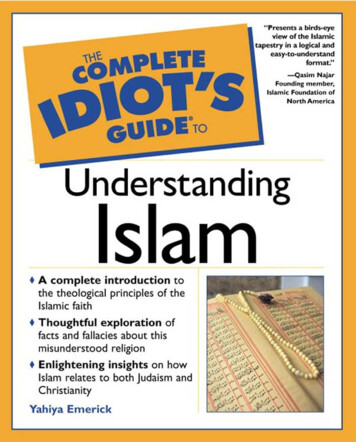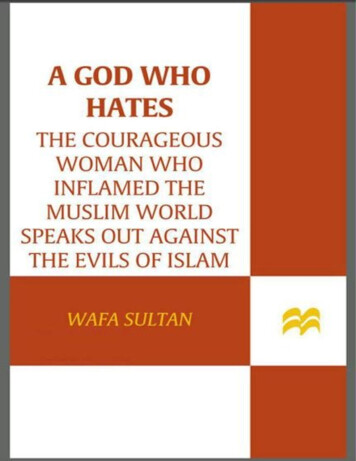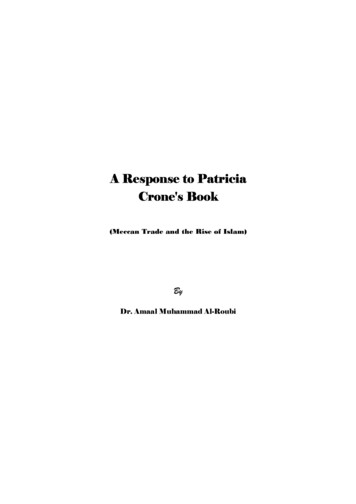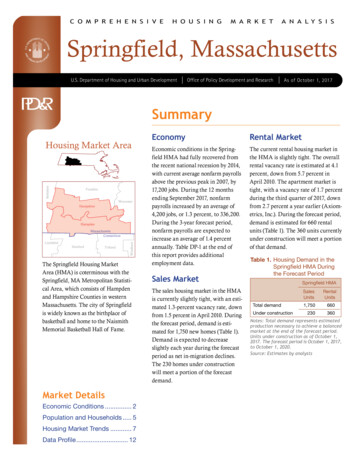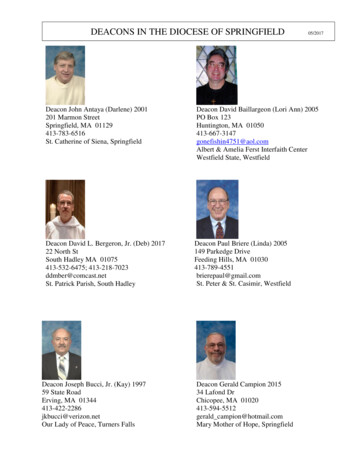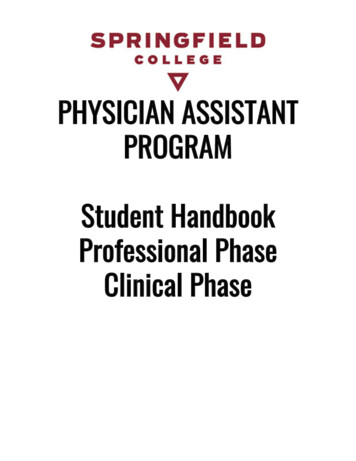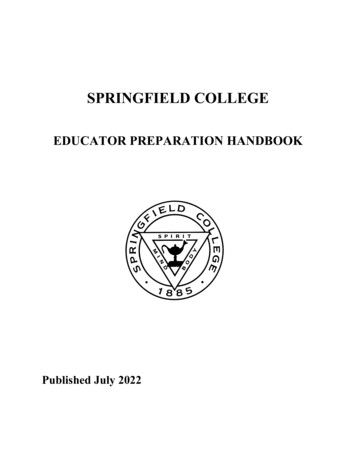
Transcription
Page 1 of 61The Rise of IslamMAIN IDEARELIGIOUS AND ETHICALSYSTEMS Muhammad unifiedthe Arab people both politicallyand through the religion of Islam.WHY IT MATTERS NOWAs the world’s fastest-growingmajor religion, Islam has astrong impact on the lives ofmillions today.TERMS & NAMES AllahMuhammadIslamMuslimHijrah mosquehajjQur’anSunnashari’aSETTING THE STAGE The cultures of the Arabian Peninsula were in constantcontact with one another for centuries. Southwest Asia (often referred to as theMiddle East) was a bridge between Africa, Asia, and Europe, where goods weretraded and new ideas were shared. One set of shared ideas would become a powerful force for change in the world—the religion of Islam.Deserts, Towns, and Trade RoutesThe Arabian Peninsula is a crossroads of three continents—Africa, Europe, andAsia. At its longest and widest points, the peninsula is about 1,200 miles fromnorth to south and 1,300 miles from east to west. Only a tiny strip of fertile landin south Arabia and Oman and a few oases can support agriculture. The remainder of the land is desert, which in the past was inhabited by nomadic Arab herders.Desert and Town Life On this desert, the Arab nomads, called Bedouins(BEHD oo ihnz), were organized into tribes and groups called clans. These clansprovided security and support for a life made difficult by the extreme conditionsof the desert. The Bedouin ideals of courage and loyalty to family, along withtheir warrior skills, would become part of the Islamic way of life.The areas with more fertile soil and the larger oases had enough water to support farming communities. By the early 600s, many Arabs had chosen to settlein an oasis or in a market town. Larger towns near the western coast of Arabiabecame market towns for local, regional, and long-distance trade goods.TAKING NOTESSynthesizing Use adiagram to list importantaspects of Islam.IslamEvents inthe life ofMuhammadBeliefs ofIslamSources ofauthorityCrossroads of Trade and Ideas By the early 600s, trade routes connectedArabia to the major ocean and land trade routes, as you can see on the map on thenext page. Trade routes through Arabia ran from the extreme south of the peninsula to the Byzantine and Sassanid (Persian) empires to the north. Merchants fromthese two empires moved along the caravan routes, trading for goods from the SilkRoads of the east. They transported spices and incense from Yemen and otherproducts to the west. They also carried information and ideas from the world outside Arabia.Mecca During certain holy months, caravans stopped in Mecca, a city in western Arabia. They brought religious pilgrims who came to worship at an ancientshrine in the city called the Ka’aba (KAH buh). The Arabs associated this houseThe Muslim World 263
Page 2 of 640 ETrade Routes, A.D. 5700500 MilesAralSeaBlack Sea0Constantinople1,000 KilometersBukhara40 NCaspianSeaTigriPalmyra MosulEuphratesCtesiphonR.To SpainDamascusMediterranean lfdSeaspicesincenseperfumesprecious metalsivorysilkMedinaRe. To IndiaSirafanRTropic of CancerPERSIAPetraEGYPTTrade GoodsBrought to ArabiaTo theSilk RoadsMuscatMeccaTo IndiaARABIALand routeSea routeHijrahByzantine EmpireSassanid EmpireArabianSeaYEMENAdenTo EastAfricaGEOGRAPHY SKILLBUILDER: Interpreting Maps1. Location Why is Arabia’s location a good one for trade?2. Movement Why was the location of Mecca ideal for the spread of ideas?of worship with Abraham, a Hebrew prophet and a believer in one God. Over theyears, they had introduced the worship of many gods and spirits to the place. TheKa’aba contained over 360 idols brought by many tribes.The concept of belief in one God, called Allah (AL luh) in Arabic, was knownon the Arabian Peninsula. Many Christians and Jews lived there and practicedmonotheism. Into this mixed religious environment of Mecca, around A.D. 570,Muhammad was born.The Prophet MuhammadMuhammad (mu HAM id) was born into the clan of a powerful Meccan family.Orphaned at the age of six, Muhammad was raised by his grandfather and uncle.He received little schooling and began working in the caravan trade as a veryyoung man. At the age of 25, Muhammad became a trader and business managerfor Khadijah (kah DEE juh), a wealthy businesswoman of about 40. Later,Muhammad and Khadijah married. Theirs was both a good marriage and a goodbusiness partnership.Revelations Muhammad took great interest in religion and often spent time alonein prayer and meditation. At about the age of 40, Muhammad’s life was changedovernight when a voice called to him while he meditated in a cave outside Mecca.According to Muslim belief, the voice was that of the angel Gabriel, who told264 Chapter 10
Page 3 of 6Muhammad that he was a messenger of Allah. “What shall I proclaim?” askedMuhammad. The voice answered:AnalyzingPrimary SourcesWhat kind ofteaching does thephrase “the use ofthe pen” refer to?PRIMARY SOURCEProclaim! In the name of thy Lord and Cherisher, who created man out of a (mere) clotof congealed blood. Proclaim! And thy Lord is most bountiful. He who taught (the useof) the pen taught man that which he knew not.QUR’AN, sura 96:1–5After much soul-searching, Muhammad came to believe that the Lord who spoketo him through Gabriel was Allah. Muhammad became convinced that he was the lastof the prophets. He began to teach that Allah was the one and only God and that allother gods must be abandoned. People who agreed to this basic principle of Islamwere called Muslims. In Arabic, Islam (ihs LAHM) means “submission to the willof Allah.” Muslim (MOOZ lim) means “one who has submitted.” Muhammad’swife, Khadijah, and several close friends and relatives were his first followers.By 613, Muhammad had begun to preach publicly in Mecca, but he met withsome hostility. Many Meccans believed his revolutionary ideas would lead toneglect of the traditional Arab gods. They feared that Mecca would lose its position as a pilgrimage center if people accepted Muhammad’s monotheistic beliefs.The Hijrah After some of his followers had been attacked, Muhammad decided toleave Mecca in 622. Following a small band of supporters he sent ahead,Muhammad moved to the town of Yathrib, over 200 miles to the north of Mecca.This migration became known as the Hijrah (hih JEE ruh). The Hijrah to Yathribmarked a turning point for Muhammad. He attracted many devoted followers. Later,Yathrib was renamed Medina.In Medina, Muhammad displayedimpressive leadership skills. He fashioned an agreement that joined his ownpeople with the Arabs and Jews ofMedina as a single community. Thesegroups accepted Muhammad as a political leader. As a religious leader, he drewmany more converts who found his message appealing. Finally, Muhammad alsobecame a military leader in the growinghostilities between Mecca and Medina.The Abyssinianarmy set out todestroy theKa’aba. Theirelephants,however,refusedto attack. Returning to Mecca In 630, the Prophetand 10,000 of his followers marched to theoutskirts of Mecca. Facing sure defeat,Mecca’s leaders surrendered. The Prophetentered the city in triumph. He destroyedthe idols in the Ka’aba and had the call toprayer made from its roof.Most Meccans pledged their loyaltyto Muhammad, and many converted toIslam. By doing so, they joined theumma, or Muslim religious community.Muhammad died two years later, atabout the age of 62. However, he hadtaken great strides toward unifying theentire Arabian Peninsula under Islam.The Muslim World 265
Page 4 of 6The Dome of the RockThe Dome of the Rock, located in Jerusalem, is the earliest survivingIslamic monument. It was completed in 691 and is part of a larger complex, which is the third most holy place in Islam. It is situated on MountMoriah, the site of the Jewish temple destroyed by Romans in A.D. 70.The rock on the site is the spot from which Muslims say Muhammadascended to heaven to learn of Allah’s will. With Allah’s blessing,Muhammad returned to earth to bring God’s message to all people. Jewsidentify the same rock as the site where Abraham was prepared to sacrifice his son Isaac.This model displays the interior ofthe building. The dome is about 100feet tall and 60 feet in diameter. Itrests on 16 pillars and columns and issurrounded by an octagonal colonnadeof 24 pillars and columns. The exteriorwalls are about 60 feet long, 36 feettall, and also form an octagon. The ornate decorations of the exterior are alsofound on the interior of the building. Notice thegeometric designs that appear in everything fromthe tile to the carpet. This is a feature often foundin Muslim art. SKILLBUILDER: Interpreting Visual Sources1. Making Inferences If you knew nothing about this building, what elements of the buildingmight give you the impression that it is a religious structure?2. Comparing and Contrasting How is the Dome of the Rock similar to or different from otherreligious buildings you have seen?266
Page 5 of 6Beliefs and Practices of IslamThe main teaching of Islam is that there is only one God, Allah. All other beliefsand practices follow from this teaching. Islam teaches that there is good and evil,and that each individual is responsible for the actions of his or her life.The Five Pillars To be a Muslim, all believers have to carry out five duties. Theseduties are known as the Five Pillars of Islam. Faith To become a Muslim, a person has to testify to the followingstatement of faith: “There is no God but Allah, and Muhammad is theMessenger of Allah.” This simple statement is heard again and again inIslamic rituals and in Muslim daily life. Prayer Five times a day, Muslims face toward Mecca to pray. They mayassemble at a mosque (mahsk), an Islamic house of worship, or whereverthey find themselves. Alms Muhammad taught that all Muslims have a responsibility to supportthe less fortunate. Muslims meet that social responsibility by giving alms,or money for the poor, through a special religious tax. Fasting During the Islamic holy month of Ramadan, Muslims fastbetween dawn and sunset. A simple meal is eaten at the end of the day.Fasting serves to remind Muslims that their spiritual needs are greaterthan their physical needs. Pilgrimage All Muslims who are physically and financially able performthe hajj (haj), or pilgrimage to Mecca, at least once. Pilgrims wear identicalgarments so that all stand as equals before Allah.A Way of Life Carrying out the Five Pillars of Islam ensures that Muslims livetheir religion while serving in their community. Along with the Five Pillars, thereare other customs, morals, and laws for Islamic society that affect Muslims’ dailylives. Believers are forbidden to eat pork or to drink intoxicating beverages. Fridayafternoons are set aside for communal worship. Unlike many other religions, Islamhas no priests or central religious authority. Every Muslim is expected to worshipAllah directly. Islam does, however, have a scholar class called the ulama. Theulama includes religious teachers who apply the words and deeds of Muhammadto everyday life.Sources of Authority The original source of authority for Muslims is Allah.According to Islamic belief, Allah expressed his will through the angel Gabriel, whorevealed it to Muhammad. WhileMuhammad lived, his followersmemorized and recited the revelations he received from Gabriel.Soon after the Prophet’s death, itwas suggested that the revelationsbe collected in a book. This book isthe Qur’an (kuh RAN), the holybook of the Muslims.The Qur’an is written inArabic, and Muslims consideronly the Arabic version to be thetrue word of Allah. Only Arabiccan be used in worship. WhereverMuslims carried the Qur’an,Arabic became the language ofworshipers and scholars. Thus, theArtistsdecorate theQur’an as aholy act. Thegeometricdesign oftenrepeats to showthe infinitequality of Allah. The Muslim World 267
Page 6 of 6Arabic language helped unite conquered peoples asMuslim control expanded.Muslims believe that Muhammad’s mission as aprophet was to receive the Qur’an and to demonstratehow to apply it in life. To them, the Sunna (SOON uh),or Muhammad’s example, is the best model for properliving. The guidance of the Qur’an and Sunna was assembled in a body of law known as shari’a (shah REE ah).This system of law regulates the family life, moral conduct, and business and community life of Muslims.Muslim PrayerLinks to Judaism and Christianity To Muslims, AllahFive times a day—dawn, noon, midafternoon, sunset, and evening—Muslims face toward Mecca to pray.Worshipers are called to prayer by amuezzin. The call to prayer sometimesis given from a minaret and even overpublic address systems or the radio inlarge cities.Because they believe that standingbefore Allah places them on holyground, Muslims perform a ritualcleansing before praying. They alsoremove their shoes.is the same God that is worshiped in Christianity andJudaism. However, Muslims view Jesus as a prophet, notas the Son of God. They regard the Qur’an as the word ofAllah as revealed to Muhammad, in the same way thatJews and Christians believe the Torah and the Gospelswere revealed to Moses and the New Testament writers.Muslims believe that the Qur’an perfects the earlier revelations. To them, it is the final book, and Muhammad wasthe final prophet. All three religions believe in heaven andhell and a day of judgment. The Muslims trace theirancestry to Abraham, as do the Jews and Christians.Muslims refer to Christians and Jews as “people of thebook” because each religion has a holy book with teachings similar to those of the Qur’an. Shari’a law requiresMuslim leaders to extend religious tolerance toChristians and Jews. A huge Muslim empire, as you willlearn in Section 2, grew to include people of many different cultures and religions.INTERNET ACTIVITY Create a chart inwhich you identify and explain themeaning of Muslim prayer rituals. Go toclasszone.com for your research.1SECTIONClarifyingWhat are thesources of authorityfor Muslims?ASSESSMENTTERMS & NAMES 1. For each term or name, write a sentence explaining its significance. Allah Muhammad Islam Muslim Hijrah mosque hajj Qur’an Sunna shari’aUSING YOUR NOTESMAIN IDEASCRITICAL THINKING & WRITING2. What event in the life of3. Why was Mecca an important6. RECOGNIZING EFFECTS How did the beliefs and practicesMuhammad signaled thebeginning of Islam?city in western Arabia?4. What are the Five Pillars ofIslam?Islam5. Why did Muslims considerEvents inthe life ofMuhammadBeliefs ofIslamChristians and Jews “people ofthe book”?Sources ofauthorityof Islam create unity and strength among Muslims in the600s?7. COMPARING In what ways are the teachings of theMuslims similar to those of Christians and Jews?8. DRAWING CONCLUSIONS How did Islam help spreadArabic culture?9. WRITING ACTIVITY RELIGIOUS AND ETHICAL SYSTEMSWrite a letter to Muhammad, describing his legacy andthat of Islam today.CONNECT TO TODAY PREPARING AN ORAL REPORTToday, tensions run high between Muslims and Jews in the Middle East. Research to find outthe causes of this tension. Present your findings in an oral report.268 Chapter 10
these two empires moved along the caravan routes, trading for goods from the Silk Roads of the east. They transported spices and incense from Yemen and other products to the west. They also carried information and ideas from the world out-side Arabia. Mecca During certain holy months, caravans stopped in Mecca, a city in west-ern Arabia.


